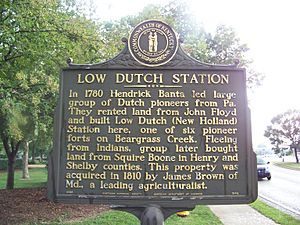Low Dutch Station facts for kids
Low Dutch Station was a small settlement built in 1780 in Kentucky. It was located near Beargrass Creek. This place was like a small fort or a protected village. It was settled by pioneers from Pennsylvania who were of Dutch heritage. Because of this, it was also called New Holland Station.
Low Dutch Station was one of seven similar forts built along Beargrass Creek around that time. Today, this area is part of Louisville. The leader of these Dutch settlers was a man named Hendrick Banta.
Contents
Who Were the Low Dutch Settlers?
The settlers at Low Dutch Station were part of a group called the "Low Dutch Company." This group was very organized. They had their own rules, a formal plan, and even ways to keep track of their money.
Why Did They Form a Company?
The main goal of the Low Dutch Company was to keep their language, culture, and religion alive. They wanted to preserve their Dutch heritage in their new home. These settlers had traveled from another settlement near Harrodsburg to establish Low Dutch Station.
Understanding Dutchmans Lane
It's easy to get confused, but Low Dutch Station has no connection to a nearby road called Dutchmans Lane. This road is in St. Matthews.
How Did Dutchmans Lane Get Its Name?
Dutchmans Lane was originally named Deutschman's Lane. This name came from Louis J. Hollenbach Sr. He was a German-American businessman in Louisville in the early 1900s. The road led to his farm. During World War I, there was a lot of anti-German feeling. Because of this, the name was shortened from "Deutschman" (which means "German man") to "Dutchman."
Finding the Historical Marker
You can find a special bronze plaque that marks the spot of Low Dutch Station. It's on the south side of Kresge Way. This marker is about 200 feet east of the traffic light where Browns Lane and the Baptist Hospital East Emergency Entrance meet Kresge Way.
What Does the Marker Say?
The original marker for Low Dutch Station went missing for a while. It has since been replaced with a new one. The new marker has slightly different words. It now says there were "seven" pioneer forts along Beargrass Creek, not "six."
The text on the new marker reads: In 1780 Hendrick Banta led a large group of Dutch settlers down the Ohio River to the Falls of the Ohio from Pennsylvania. They rented land from John Floyd and built Low Dutch (New Holland) Station, one of seven forts on Beargrass Creek. In 1810, leading agriculturalist James Brown of Maryland, acquired the property.
Images for kids
-
The historic Brown Family Cemetery is in the southeast corner of Browns Park, about 1400 ft. southeast of the historical marker for Low Dutch Station; the primary families represented by the old tombstones are Brown, Forman, Galt, Lawrence, & Pope, along with single stones each for Anderson & Hobbs, and two infants of the Nicholas family.



